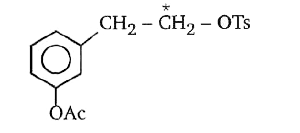Cramps are formed during vigrous exercise, it is due to production of ____ in muscles.
Acetyl coenzyme A
Ethyl alcohol
Lactic acid
Acetic acid
The correct Answer is:C
Step-by-Step Solution:
1. Understanding the Context: The question asks about the substance produced in muscles during vigorous exercise that leads to cramps.
2. Identifying the Options: The options provided are:
- Acetyl-CoA
- Coenzyme A
- Ethyl alcohol
- Lactic acid
- Acetic acid
3. Analyzing Each Option:
- Acetyl-CoA: This is produced during aerobic respiration in the mitochondria and is utilized in the Krebs cycle to produce ATP. It does not cause cramps, so this option is incorrect.
- Coenzyme A: This is a cofactor involved in various biochemical reactions, including the synthesis and oxidation of fatty acids. It does not directly relate to muscle cramps, so this option is also incorrect.
- Ethyl alcohol: This is produced during anaerobic respiration (fermentation) when pyruvic acid is converted in the absence of oxygen. While it is a byproduct of fermentation, it is not the primary cause of cramps, making this option incorrect.
- Lactic acid: This is produced during anaerobic respiration, specifically lactic acid fermentation. When oxygen levels are low during intense exercise, pyruvic acid is converted into lactic acid, which accumulates in the muscles and is responsible for cramps. This option is correct.
- Acetic acid: This is not directly related to muscle cramps and is produced in different metabolic pathways. Thus, this option is incorrect.
4. Conclusion: The substance that accumulates in muscles during vigorous exercise and causes cramps is lactic acid.
Final Answer: Lactic acid
---
- Acetyl-CoA
- Coenzyme A
- Ethyl alcohol
- Lactic acid
- Acetic acid
- Acetyl-CoA: This is produced during aerobic respiration in the mitochondria and is utilized in the Krebs cycle to produce ATP. It does not cause cramps, so this option is incorrect.
- Coenzyme A: This is a cofactor involved in various biochemical reactions, including the synthesis and oxidation of fatty acids. It does not directly relate to muscle cramps, so this option is also incorrect.
- Ethyl alcohol: This is produced during anaerobic respiration (fermentation) when pyruvic acid is converted in the absence of oxygen. While it is a byproduct of fermentation, it is not the primary cause of cramps, making this option incorrect.
- Lactic acid: This is produced during anaerobic respiration, specifically lactic acid fermentation. When oxygen levels are low during intense exercise, pyruvic acid is converted into lactic acid, which accumulates in the muscles and is responsible for cramps. This option is correct.
- Acetic acid: This is not directly related to muscle cramps and is produced in different metabolic pathways. Thus, this option is incorrect.
Topper's Solved these Questions
- RESPIRATION IN PLANTS BOOK - AAKASH INSTITUTE ENGLISHCHAPTER - RESPIRATION IN PLANTS EXERCISE - Assignment (Section B)
35 Videos
- RESPIRATION IN PLANTS BOOK - AAKASH INSTITUTE ENGLISHCHAPTER - RESPIRATION IN PLANTS EXERCISE - Assignment (Section C)
39 Videos
- RESPIRATION IN PLANTS BOOK - AAKASH INSTITUTE ENGLISHCHAPTER - RESPIRATION IN PLANTS EXERCISE - Exercise
20 Videos
- REPRODUCTIVE HEALTH BOOK - AAKASH INSTITUTE ENGLISHCHAPTER - REPRODUCTIVE HEALTH EXERCISE - Sectoin -D Assertion - Reason Type Questions
22 Videos
- SEXUAL REPRODUCTION IN FLOWERING PLANTS BOOK - AAKASH INSTITUTE ENGLISHCHAPTER - SEXUAL REPRODUCTION IN FLOWERING PLANTS EXERCISE - Assignment (SECTION D)
20 Videos
Similar Questions
Knowledge Check
During strenuous exercise, glucose is converted into
AstarchBglycogenCpyruvic acidDlactic acidProduct(s) formed during this reaction is/are :
 A
A B
B C
C Dboth (a) and (b)
Dboth (a) and (b)The muscle fatigue is due to:
ANa+BK+Clactic acidDcitric acid